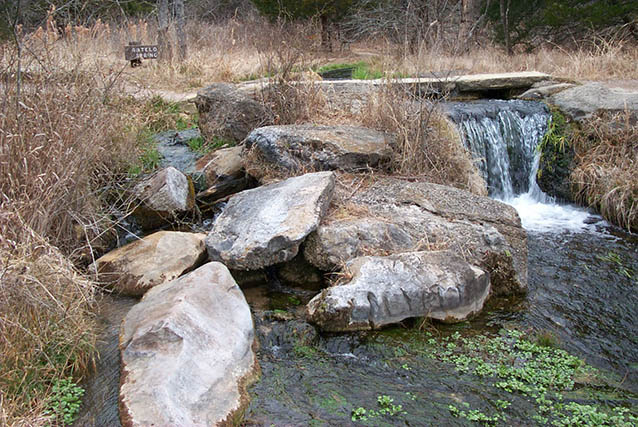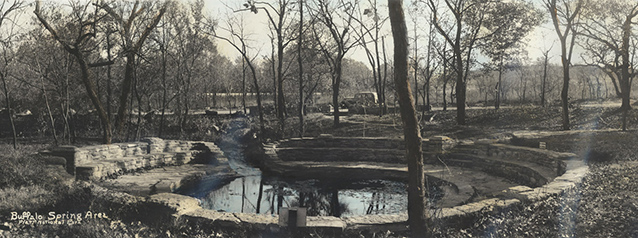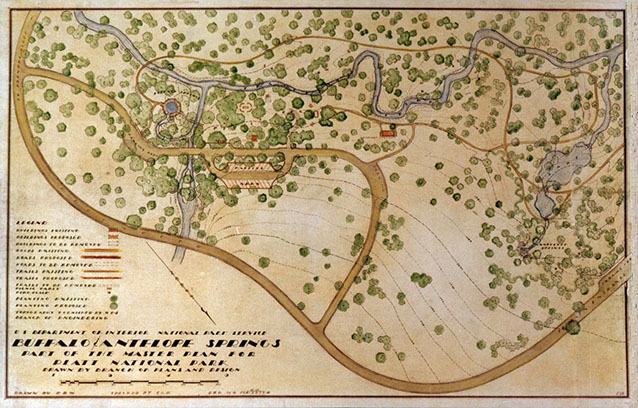Antelope and Buffalo Springs (and the Travertine Nature Center) are part of a historic, designed landscape located on the far eastern portion of the Platt National Park National Historic Landmark District, part of Chickasaw National Recreation Area in Oklahoma. The Antelope and Buffalo Springs landscape, comprised of approximately 142 acres of wooded habitat, is to the east of Travertine Island and Little Niagara Falls.
Although the area contains elements dating to before 1930, the large majority of this component landscape was constructed in the 1930s by CCC crews. It reflects principles of NPS Rustic design in planning, style, and construction.

NPS/ K. Ruhnke
Buffalo and Antelope Springs, which form the source of Travertine Creek, emerge from this area. Travertine Creek, lined with rock outcroppings, flows through the area from east to west. Many of the built elements within the area were constructed in the 1930s. The Travertine Nature Center and its parking area were added later, during the Mission 66 era of development.
Formerly the site of one of the park’s major picnic areas, the area is now primarily used for passive recreation such as hiking, walking, and nature study. A series of signs interpreting vegetation line the area’s trail. Remnants of the former picnic area and Perimeter Road exist around Buffalo and Antelope Springs. Today the realigned Perimeter Road skirts the western edge of the landscape at the Travertine Nature Center, providing vehicle access.

NPS / CHIC Archives
As a whole, Antelope and Buffalo Springs is significant for its association with the former Platt National Park (a National Historic Landmark District), which is now encompassed within Chickasaw National Recreation Area. The district is important for its association with the development of national park landscapes completed during the Great Depression and funded as part of Franklin Delano Roosevelt’s “New Deal” programs.
The area is also significant as embodying the characteristics of the type, period, and methods of construction typical of the “Rustic style” of park design developed by the National Park Service in the years between World War I and World War II (1916-1942) under the leadership of Thomas Vint. In general terms, Rustic park design limited development to preserve natural scenery, and buildings and structures were designed in harmony with the natural landscape. This meant using hand craftsmanship, local architectural styles and natural materials such as stone, wood, and native plants in the design of each park structure or element.

NPS / CHIC Archives
Although the Buffalo and Antelope Springs area contains elements dating to before 1930, the large majority of this landscape was constructed in the 1930s by Civilian Conservation Corps (CCC) crews. In its site planning, architectural style, landscape architectural design, and small scale features, the landscape reflects NPS principles of Rustic design and construction. This is particularly evident in the Buffalo Springs seat walls and comfort station.
The design of the original Perimeter Road and its associated bridges, the area’s water crossings, signage, and stone steps are all excellent examples of the CCC era landscape engineering projects undertaken in Platt National Park. The extant landscape features throughout the area are representative of the finest CCC work in existence, in terms of Rustic design, the number and variety of structures, and construction techniques and materials.
In addition to the historic significance of the 1930s features, the Travertine Nature Center is listed on the National Register of Historic Places. The development of the Nature Center structure and its site in the 1960s is significant for its association with Mission 66, a nationwide National Park Service effort to modernize its facilities.
Quick Facts
- Cultural Landscape Type: Designed
- National Register Significance Level: National
- National Register Significance Criteria: A, C
- National Historic Landmark
- Period of Significance: 1933-1940
Landscape Links
Part of a series of articles titled Cultural Landscapes of Chickasaw National Recreation Area.
Last updated: December 30, 2019
